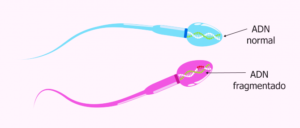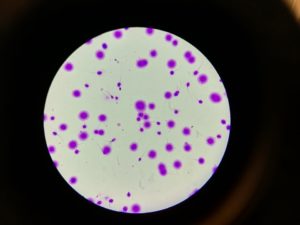
Sperm DNA fragmentation and its importance to achieve a pregnancy.
Sperm DNA fragmentation refers to breaks or lesions in the genetic material of the sperm located on the inside of the head.

The greater the number of injuries, the lower the integrity of the genetic material and the probability that pregnancy cannot occur naturally.
Origin of spermatic DNA fragmentation.
It has been proposed that the main origin of sperm DNA fragmentation is due to oxidative stress. This molecular event occurs when there is an imbalance between the formation of reactive oxygen species and antioxidant defense. Various investigations have shown the relationship between lower antioxidant capacity and high degrees of oxidative stress in semen samples.
Causes of alterations in sperm DNA.
The causes are various and can be intrinsic or induced by external factors.
A DNA Fragmentation test is recommended in the following cases:
- Idiopathic infertility (of unknown cause).
- After repeated failures in assisted reproduction techniques.
- Poor embryonic quality.
- Repeated abortions.
- Varicocele.
- Elderly males.
- Leukospermia.
- Genitourinary tract infections.
- Testicular cancer.
- Radio / chemotherapy.
Detection methods for spermatic DNA fragmentation.
There are several methods to measure the levels of fragmentation. For example, the TUNEL test with flow cytometry and the SCD test. Other fragmentation tests, such as SCSA and SCD, measure the potential damage and susceptibility to DNA denaturation and therefore have a lower predictive level.
In our center, the analysis of sperm DNA fragmentation is performed using the “Sperm DNA kit” test, which allows us to have a diagnosis quickly, easily and accurately. This method evaluates the fragmentation of the spermatic DNA in relation to the size of the chromatin dispersion halo.
Not Fragmented
- Enlarged Halo / 2. Regular Halo

Fragmented
3 Small Halo | 4. without Halo | 5. lower Halo

Reference values: It is considered pathological when the DNA Fragmentation Index (IFD)> 30%.

Image of a seminal sample treated for DNA fragmentation analysis showing sperm with halo (un fragmented DNA) and sperm without halo (fragmented DNA).
